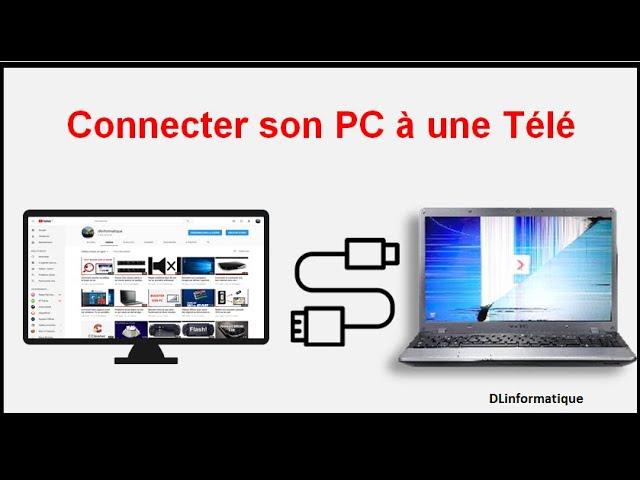Connecting your PC to your TV, via HDMI or wirelessly, is quite simple and allows you to take advantage of the advantages of the big screen. Here's how.
If you're tired of your small laptop screen, maybe you know you can use your TV's big screen. It's good to be able to enjoy the comfort of your sofa to surf the web, play PC games or watch videos. Or maybe just to see your loved ones in a big way during a video call.
Using your TV as a monitor has some drawbacks, however. Text can be small, input lag can get in the way during your games, and while the couch might feel comfortable, it's painful in the long run. Not to mention mice, trackpads and keyboards. But the PC-to-TV connection can be very interesting in many situations. And the coolest thing about it all is that it's almost free.
Mirror vs Extension
In mirror mode, you display the same content on your computer screen and on the TV. This is more common than the extension of the screen - which comes to make the TV a simple extension of the screen of your computer -. The extension can be useful for watching a YouTube video while you work. It's a little more complex but possible, depending on your equipment. We will mainly talk about the mirror in this article.
The simplest: the HDMI cable
The most basic PC-to-TV connection requires an HDMI cable from your computer to an HDMI input on your TV. If you have an old television or an old computer, you will have the VGA option, an antique, but which does the same job.
Computers, laptops or not, have a wide variety of connectors. To find out which cable you will need, you will have to find out about the specifications of your device – a Google search will quickly give you the answer -.
“Classic” HDMI: If you're lucky your laptop has a standard HDMI output, a standard HDMI cable will do.
Mini or micro HDMI: these more compact versions of HDMI need an adapter or cable with the same connection on one side and a classic HDMI on the other side, to be connected directly to the TV.

Thunderbolt, DisplayPort, or Mini DisplayPort: These work great with HDMI. Thunderbolt is present on many laptops. The first two versions were identical to the Mini DisplayPort. The newer ones use the same connector as USB-C. The classic DisplayPort port is quite common on Windows PCs. Again, you'll need an adapter or cable with this type of connection on one end and HDMI on the other.
USB-C: Most modern laptops have this. You will need a USB-C to HDMI adapter and you will be done. But sometimes it won't work at all. USB-C uses the same connector as Apple's Thunderbolt 3.
Other tips: there are a lot of models of laptops and connectors. Difficult to cover all cases. If in doubt, use Google to find out before you buy.
In some cases, the quality could also be reduced. You probably won't have HDR or 4K either. If you want the best possible quality, you should opt for another method, such as through a TV box or Blu-ray player.
Wireless connections
There are several possibilities to do without cables. Again, this depends on your computer and the capabilities of your TV, or the box connected to it.
If you have an Apple computer: the easiest way is to use AirPlay. But you will need a device that is compatible, in other words, Apple TV, Apple TV 4K, an Air Play 2 compatible TV (2019 or newer models from Samsung, Sony, LG or Vizio).
If you have a Windows PC: there is a tool called Miracast, not as widespread as AirPlay but your Windows 10 computer should have it. On the TV side, you need a compatible box, a natively compatible TV or a wireless adapter to plug into the TV.
If you have a Chromebook: Computers running Chrome OS can stream content to a TV wirelessly. You need a Chromecast, a Chromecast Ultra, a Smart TV with built-in Chromecast, an Nvidia Shield box or a Sony TV running Android TV.
Cast from the Chrome browser: if you don't have a compatible device, it is still possible to cast your screen to the TV via the Chrome browser. Only the content in the browser will be visible and some sites will not work.
You can also stream content directly from a mobile app, like Netflix or YouTube, to many Smart TVs. It's not about mirroring but just streaming content from your phone to a big screen. Very easy and quite effective.
If you want to play video games, the latency of the wireless connection will certainly prevent you from enjoying them in good conditions. Especially egregious with games like shooters and simulation games.
Accessories
To improve the experience, we will quickly need some accessories. A wireless keyboard and/or mouse will make it much more enjoyable.
Wireless keyboard
With a wireless keyboard, you can leave your computer at a distance and only keep the keyboard on your lap. The Logitech K380 offers good battery life, can easily switch between devices (smartphone, tablet, etc.) and is not expensive.
Wireless mouse
There are many mouse options, but the noiseless Logitech M590 Multi-Device is particularly comfortable and above all very discreet. You won't have to suffer from unwanted clicking noise. It is also very affordable.
Learn more